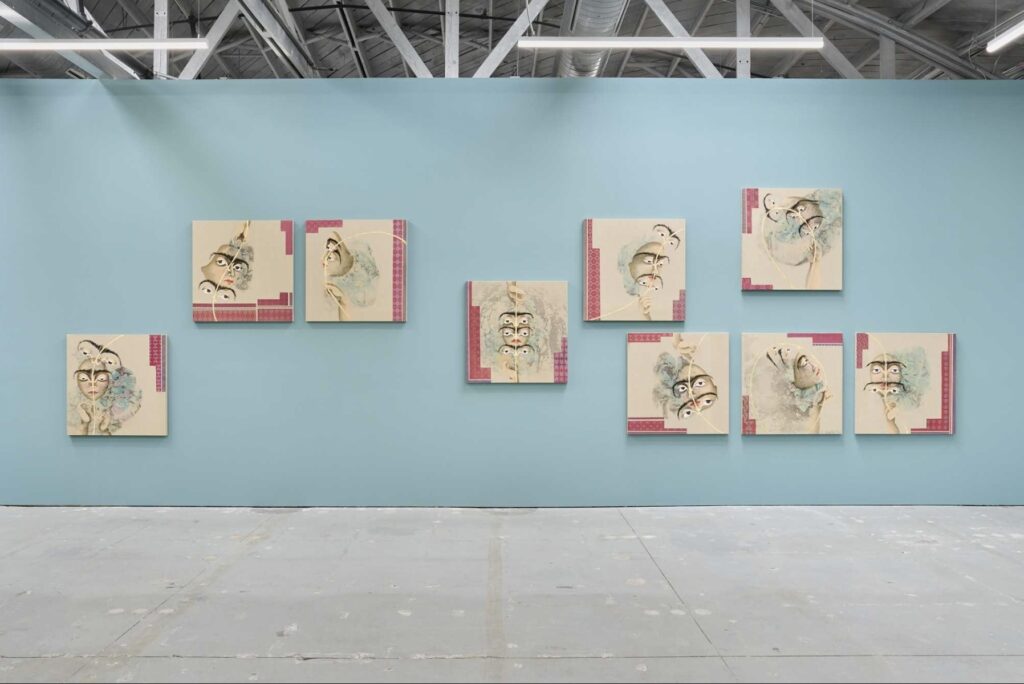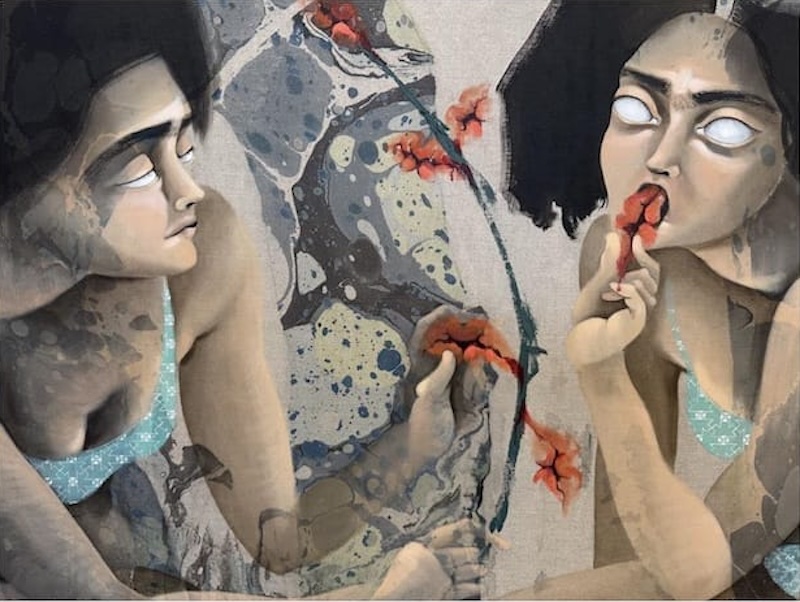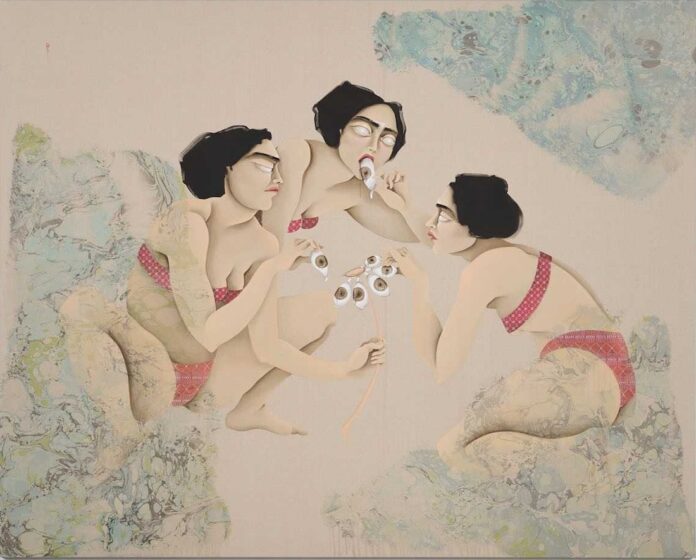Among the works in “Look Me in the Eyes” (through May 19 at the Institute of Contemporary Art San Francisco), Los Angeles-based artist Hayv Kahraman presents five especially captivating large scale paintings: “Love Me Love Me Not,” “Eyeris,” “T Prayer Hands,” “Lip Plants,” and “Weedwreath” (all 2023). Within Karman’s works, the artist references her Kurdish and Iraqi backgrounds with an Ottoman marbling technique, textiles patterns, and a surreal mythology of female figures, where eyes, lips, and plants become haunting metaphors within ambiguous landscapes.
While Kurdistan is recognized as a cultural and geographic zone spanning southeastern Turkey, northern Syria, northern Iraq, and northeastern Iran, it is not a nation state and, with varying degrees of autonomy, is subject to the governments of four different countries. With Kurds caught between citizenships, languages, cultures, and some calls for independence, Kahraman’s sense of place become even more fractured as her family fled to Sweden as refugees of the Gulf War (1990-91).
Throughout Kahraman’s paintings, her narrative centers female figures whose olive skin-tone contrasts prominent dark bushy eyebrows, masses of ebony hair, and full crimson lips. Most significantly though, Kahraman paints her figures with large white almond-shaped eyes, void of pupils. The vacant eyes suggest a haunting parable of sightlessness, being unseen, or bearing witness to/being blinded by historical or present-day traumas.

Like an allegorical image, which frequently feature clusters of women or muses in pastoral or heavenly settings, Kahraman’s compositions feature two to four nude or bathing-suit clad figures crouching or sitting on the ground in an ambiguous landscape. Against the paintings’ raw linen backgrounds, the figure’s flesh only tonally contrasts the tan fields, which are also punctuated with shapes of marbleized patterns in the tradition of Ebru, a 16th century Ottoman era marbling technique. The Ebru’s organic swirls of muted browns, greens, and black have an almost psychedelic pattern of moving liquid, adding to the dream-like narrative and sense of dislocation.
Within the exhibition, “Eyeris” seems to lay the foundation for the artist’s mythology of eyes. In the work, a woman cradles another, whose supine posture suggests she’s been stricken ill, dying, or dreaming. Most surreally, a plant emerges from the lying woman’s eyes; in lieu of leaves, the plant sprouts eyes with pupils, highlighting the absence of pupils amongst the women. With the figure on the lower right corner reaching for an eye/leaf while the center figure pulls her left eye down, Kahraman begins to weave a tale of how women see; how pupils, or their absence, indicates vision/blindness; and how visibility grows or is shared.

In “Lip Plants,” Kahraman extends her mythology from eyes to lips. With three women sitting on the ground, the center figure ghoulishly eats a pair of lips. Additionally, the figure on the left plucks a pair of lips while glancing cautiously, or curiously, at the women consuming the lips. Kahraman suggests lips as a metaphor for consuming or ingesting in speech or nourishing oneself, which may be taboo or have dangers consequences.
Most excitingly, in “Weedwreath” Kahraman explores less obvious figuration. Set behind a camouflage-like Erbu patterned tree, two arms extend like branches. With the arms covered in green diamond textile pattern, they take on a reptilian association, which as they reach for the eyes/leaves from the plant invoke the snake from Garden of Eden, where eyes might be the ‘forbidden fruit’ of the tree of life.
Throughout Kahraman’s narrative, the artist balances making her personal and cultural background visible while shielding it from the gaze, as a form of individual and cultural protection. Her strong use of metaphor importantly pose questions about how to represent Kurdish female identity and the artist’s personal journey, where suggestion and ambiguity allow for flux, subjectivity, and poetry.
Help us save local journalism!
Every tax-deductible donation helps us grow to cover the issues that mean the most to our community. Become a 48 Hills Hero and support the only daily progressive news source in the Bay Area.
HAYV KAHRAMAN: LOOK ME IN THE EYES through May 19 at Institute of Contemporary Art, SF. More info here.




